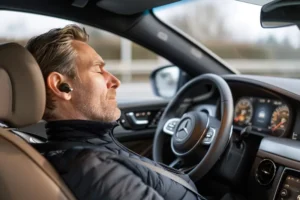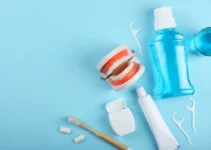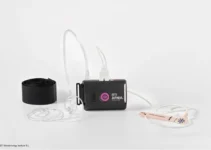Understanding the Sleep Apnea DVLA regulations is crucial for drivers diagnosed with this condition. Sleep apnea, a disorder characterized by brief interruptions of breathing during sleep, can significantly impact one’s ability to drive safely. The Driver and Vehicle Licensing Agency (DVLA) in the UK requires individuals affected by sleep apnea to meet certain medical standards to ensure road safety. This article explores the implications of sleep apnea for drivers, the DVLA’s assessment process, and what steps to take if you are affected, aiming to provide essential information to help maintain both your driving license and road safety.
“`htmlUnderstanding Sleep Apnea and Its Implications
Sleep apnea is a sleeping disorder characterized by repeated interruptions in breathing during sleep. These interruptions, known as apneas, can last from a few seconds to a few minutes and often occur multiple times throughout the night. Understanding sleep apnea is crucial because it can have significant implications for an individual’s overall health and well-being.
Research indicates that untreated sleep apnea can lead to a variety of health problems, including cardiovascular disease, hypertension, and diabetes. In addition, sleep apnea can negatively affect the quality of life by causing excessive daytime sleepiness, impairing cognitive function, and increasing the risk of accidents. Therefore, it’s essential to recognize the symptoms and seek appropriate treatment.
This article will explore the fundamentals of sleep apnea, the different types it encompasses, and the common symptoms associated with this condition.
What is Sleep Apnea?
Sleep apnea is a serious sleep disorder in which a person’s breathing is repeatedly interrupted during sleep. These interruptions are due to the airway becoming blocked or collapsing. Each pause in breathing can last from a few seconds to minutes and can occur 30 times or more an hour. The condition often goes undiagnosed because it happens during sleep, and individuals might not be aware they have it.
There are two primary mechanisms involved in sleep apnea:
- Obstructive sleep apnea (OSA): This is the more common form and occurs when the throat muscles relax excessively, causing an obstruction in the airway.
- Central sleep apnea (CSA): This form is less common and occurs when the brain fails to send the correct signals to the muscles that control breathing.
The consequences of untreated sleep apnea can be severe, leading to various cardiovascular issues, metabolic syndromes, and increased mortality risk. Recognizing and treating it effectively is vital for preventing these adverse health outcomes.
Types of Sleep Apnea
There are three main types of sleep apnea:
- Obstructive Sleep Apnea (OSA): This is the most prevalent form of sleep apnea and occurs when the muscles at the back of the throat fail to keep the airway open, despite efforts to breathe.
- Central Sleep Apnea (CSA): This type is less common and involves the central nervous system. In CSA, the brain fails to signal the muscles to breathe due to instability in the respiratory control center.
- Complex Sleep Apnea Syndrome: Also known as treatment-emergent central sleep apnea, this condition occurs when someone has both obstructive sleep apnea and central sleep apnea.
The diversity in types means that sleep apnea can manifest differently among individuals, necessitating personalized diagnostic and treatment approaches. For instance, Continuous Positive Airway Pressure (CPAP) is often highly effective for OSA but may not be as beneficial for CSA.
Understanding the specific type of sleep apnea is crucial for developing an effective treatment plan. Treatments may include lifestyle changes, the use of breathing devices, or surgery in some cases.
Common Symptoms of Sleep Apnea
While the specific symptoms of sleep apnea can vary depending on the type and severity, some common signs are frequently reported. Loud snoring is a hallmark symptom of obstructive sleep apnea, often noticed by bed partners before the affected individual becomes aware of their condition.
Other frequent symptoms include:
- Episodes of breathing cessation witnessed by another person.
- Abrupt awakenings accompanied by gasping or choking.
- Excessive daytime sleepiness (hypersomnia), which can significantly impact daily functioning and quality of life.
- Morning headaches, dry mouth, or sore throat upon waking.
Untreated sleep apnea not only impacts sleep quality but also increases the risk for severe conditions like high blood pressure, stroke, and heart disease. If you or someone you know is experiencing these symptoms, it’s essential to seek medical advice promptly. Understanding sleep apnea and its implications is just the beginning. To dive deeper into related topics, explore other articles that discuss treatment options, lifestyle adjustments, and ways to improve your overall sleep health.
“`
DVLA Guidelines on Sleep Apnea for Drivers
Sleep apnea is a serious condition that can significantly impact a person’s ability to drive safely. The Driver and Vehicle Licensing Agency (DVLA) in the UK has established specific guidelines to ensure that individuals with sleep apnea can still drive, provided they manage their condition appropriately. Understanding these guidelines is crucial for both patients and healthcare providers.
The primary goal of the DVLA guidelines is to minimize the risk of accidents related to drowsy driving, which can be a direct consequence of untreated or poorly managed sleep apnea. These guidelines lay out the responsibilities of both drivers and medical professionals in detecting, reporting, and managing sleep apnea.
Overview of DVLA Guidelines
The DVLA guidelines are designed to ensure that drivers with sleep apnea are safe to drive. They require that individuals with sleep apnea must report their condition if it affects their ability to drive. If a driver is diagnosed with obstructive sleep apnea (OSA) syndrome, they may be required to undergo treatment before they are allowed to continue driving.
Key aspects of the guidelines include:
- Mandatory reporting of sleep apnea diagnosis to the DVLA.
- Regular medical assessments to confirm that the condition is being managed effectively.
- Possible suspension of driving privileges until compliance with treatment is demonstrated.
It is essential for drivers to comply with these guidelines not only to maintain their driving privileges but also to ensure the safety of themselves and others on the road. The DVLA takes untreated or poorly managed sleep apnea seriously due to the high risk of drowsy driving accidents.
Steps to Report Sleep Apnea to DVLA
Reporting sleep apnea to the DVLA involves a clear and structured process. Failure to report can result in severe penalties, including fines and legal action. Here are the steps that individuals need to follow:
- Consult with a healthcare provider: If you suspect you have sleep apnea, consult a healthcare provider for a diagnosis.
- Obtain a formal diagnosis: A sleep study or other diagnostic tests will confirm whether or not you have sleep apnea.
- Notify the DVLA: Once diagnosed, you must inform the DVLA. This can be done by filling out the appropriate medical questionnaire available on the DVLA website.
- Undergo treatment: Begin any recommended treatments such as CPAP (Continuous Positive Airway Pressure) therapy to manage the condition.
- Regular follow-ups: Attend regular follow-up appointments to ensure the condition is under control and provide required updates to the DVLA.
Accurate and timely reporting is crucial. The DVLA will review the information provided and determine whether it is safe for the individual to continue driving. They may request additional information or medical reports as part of their assessment. For more detailed information about managing sleep apnea and its implications for driving, consider exploring our other articles on related subjects. Your health and safety, as well as that of others on the road, are of utmost importance.
Managing Sleep Apnea for Safe Driving
Sleep apnea is a severe sleep disorder that affects millions of people worldwide, leading to frequent interruptions in breathing during sleep. These interruptions can cause fragmented sleep and excessive daytime sleepiness, which significantly impairs the ability to drive safely. It is crucial to manage sleep apnea effectively to ensure both personal safety and the safety of others on the road.
Studies have shown that individuals with untreated sleep apnea are up to five times more likely to be involved in traffic accidents. Addressing this disorder not only improves overall health but also enhances one’s ability to stay alert and focused while driving. Various treatment options and lifestyle changes can help manage sleep apnea symptoms, thereby lowering the risk of drowsy driving.
In this article, we will delve into different medical treatments and lifestyle modifications that can aid in managing sleep apnea. Additionally, we will discuss the critical question of when it is safe to drive once a diagnosis has been made and treatment has commenced.
Medical Treatments for Sleep Apnea
One of the most common and effective medical treatments for sleep apnea is the use of a CPAP (Continuous Positive Airway Pressure) machine. The CPAP machine works by delivering a steady stream of air through a mask, which helps keep the airway open during sleep. This treatment has been shown to reduce episodes of apnea and improve sleep quality.
Other medical interventions may include the use of oral appliances, which are designed to reposition the jaw and tongue to keep the airway open. Surgical options, such as uvulopalatopharyngoplasty (UPPP) or maxillomandibular advancement (MMA), may also be considered in severe cases where CPAP or oral appliances are ineffective.
In some cases, medication may be prescribed to help manage symptoms of sleep apnea. For instance, stimulants like modafinil may be used to reduce excessive daytime sleepiness. However, these are typically considered as adjuncts to other primary treatments like CPAP.
Importantly, medical treatments should always be guided by a healthcare professional who can tailor the approach based on individual needs and the severity of the condition.
Lifestyle Changes to Improve Sleep Apnea
In addition to medical treatments, certain lifestyle changes can significantly improve symptoms of sleep apnea. Weight loss is one of the most impactful changes, as excess weight, particularly around the neck, can increase the risk of airway obstruction. Studies have demonstrated that even a modest reduction in weight can lead to substantial improvements in sleep apnea symptoms.
Another critical lifestyle modification is regular exercise. While exercise itself doesn’t cure sleep apnea, it can help reduce its severity by improving overall respiratory and cardiovascular health. Activities such as brisk walking, jogging, or swimming can be particularly beneficial.
- Maintaining a regular sleep schedule
- Sleeping on your side instead of your back
- Avoiding alcohol and sedatives before bedtime
- Quitting smoking, which can inflame and swell the upper airway
These lifestyle changes, when combined with medical treatments, can offer a comprehensive approach to managing sleep apnea effectively.
When is it Safe to Drive?
Determining when it is safe to drive after a sleep apnea diagnosis is crucial for preventing accidents. The key indicator is the effective management of symptoms, particularly the reduction of excessive daytime sleepiness. Once treatment has begun, individuals should monitor their alertness and consult with their healthcare provider to assess their readiness to drive.
For those using a CPAP machine, adherence to therapy is paramount. Studies suggest that using CPAP for at least four hours per night can significantly reduce the likelihood of drowsy driving. Regular follow-up appointments can help ensure that the treatment is effective and that any issues with equipment are promptly addressed.
It is also essential to listen to your body. If you still feel excessively sleepy during the day despite treatment, it may be necessary to avoid driving until symptoms are better controlled. Completing a sleep diary and keeping track of sleep patterns and alertness levels can provide valuable insights for both patients and healthcare providers.
If you’re managing sleep apnea and considering when it might be safe to return to driving, always prioritize safety over convenience. Discuss any concerns with your healthcare provider to ensure you are making informed decisions.
By effectively managing sleep apnea through a combination of medical treatments and lifestyle changes, individuals can significantly improve their quality of life and reduce the risk of driving-related accidents. For more information on sleep disorders and their management, be sure to read our other insightful articles.
Common Questions on Sleep Apnea DVLA Regulations for Drivers
Understanding sleep apnea and the DVLA guidelines is crucial for drivers. Here are some frequently asked questions to help clarify the regulations and their implications.
What are the DVLA guidelines for drivers with sleep apnea?
The DVLA requires that drivers with a diagnosis of sleep apnea that affects their ability to drive safely must stop driving and notify the agency about their condition. Drivers can resume driving once they have the appropriate treatment and medical evidence confirms that their symptoms are controlled adequately, ensuring safety on the roads.
How does sleep apnea affect driving ability?
Sleep apnea can significantly impact driving ability by causing excessive daytime sleepiness, reducing alertness, and impairing reaction times. These symptoms heighten the risk of road accidents, making it essential for affected individuals to seek treatment and compliance with DVLA regulations to ensure road safety.

My name is Salman Kapa, a 73-year-old expert in bone regeneration and dental implantology. With decades of experience in the field, I am dedicated to advancing our understanding of oral health and hygiene. Through my research and writing, I aim to contribute to the development of innovative solutions in dental care.




